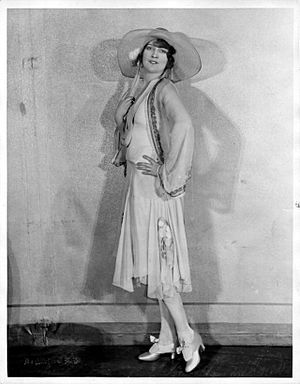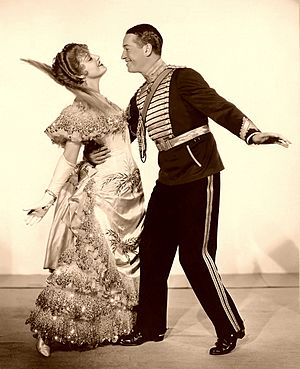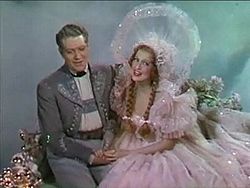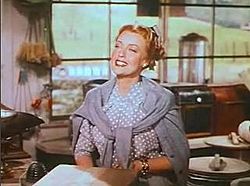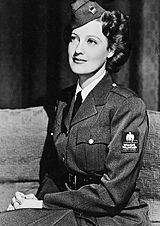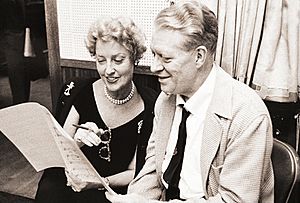Jeanette MacDonald facts for kids
Quick facts for kids
Jeanette MacDonald
|
|
|---|---|
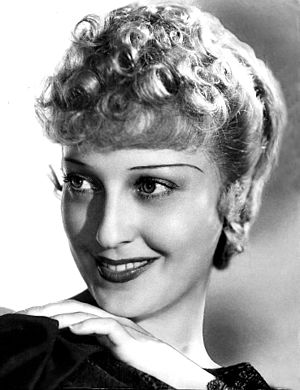
MacDonald in 1934
|
|
| Born |
Jeannette Anna McDonald
June 18, 1903 Philadelphia, Pennsylvania, U.S.
|
| Died | January 14, 1965 (aged 61) |
| Resting place | Forest Lawn Memorial Park, Glendale, California |
| Other names | Jeanette MacDonald |
| Occupation |
|
| Years active | 1909–1959 |
| Spouse(s) | |
| Partner(s) | Nelson Eddy (1935–65, her death) |
| Relatives | Blossom Rock (sister) |
| Awards |
|
| Musical career | |
| Genres | |
| Instruments | Vocals (soprano) |
| Labels |
|
Jeanette Anna MacDonald (born June 18, 1903 – died January 14, 1965) was a famous American singer and actress. She is best known for her musical movies from the 1930s. She often starred with Maurice Chevalier and Nelson Eddy.
During the 1930s and 1940s, Jeanette made 29 feature films. Four of these movies were nominated for Best Picture Oscars. She also recorded many songs and earned three gold records. Later, she performed in operas, concerts, and on radio and television. Jeanette MacDonald was a very important soprano singer of the 20th century. She helped introduce opera to movie audiences and inspired many new singers.
Contents
Early Life and Beginnings
Jeanette Anna McDonald was born on June 18, 1903, in Philadelphia, Pennsylvania. She was the youngest of three daughters. Her father was a factory foreman and salesman. Her older sister, Blossom Rock, became a well-known actress. Blossom was famous for playing "Grandmama" on The Addams Family TV show.
Jeanette started dancing lessons when she was very young. She performed in small operas and shows around her city. By age nine, she was touring in children's shows. She even led her own group called "Six Little Song Birds." Later, she changed her name to Jeanette MacDonald. She added an "A" to her last name to show her Scottish family background.
Becoming a Star: Acting Career
Broadway Stage Success
In 1919, Jeanette moved to New York City. She took singing lessons and joined the chorus of a musical show on Broadway. In the early 1920s, she appeared in several musicals. She often played the second female lead.
In 1927, Jeanette finally got a starring role in Yes, Yes, Yvette. She also starred in Sunny Days in 1928, which got great reviews. Her last Broadway play was Boom Boom in 1929. A young actor named Archie Leach, who later became Cary Grant, was also in the cast.
A famous film director, Ernst Lubitsch, saw Jeanette's screen test. He chose her to be the leading lady in his first sound film, The Love Parade. This movie starred Maurice Chevalier.
Film Career Highlights
Early Films at Paramount and Fox
Jeanette MacDonald quickly became a movie star. Her first film, The Love Parade (1929), was a big success. It was directed by Ernst Lubitsch and starred Maurice Chevalier. This movie was important for early sound films and was even nominated for Best Picture.
She also starred in The Vagabond King (1930), a colorful musical. In 1930, she made Monte Carlo, another popular film directed by Lubitsch. In this movie, she sang "Beyond the Blue Horizon," which became a famous song.
After making films for Paramount, Jeanette signed a deal with Fox Film Corporation. She hoped to produce her own movies. She made Oh, for a Man! (1930) and Don't Bet on Women (1931).
In 1931, Jeanette took a break from Hollywood to tour Europe. She performed in Paris and London. She returned to Paramount in 1932 for two more films with Maurice Chevalier. One Hour with You (1932) was filmed in both English and French. Love Me Tonight (1932) is considered a perfect film musical by many. It starred Chevalier as a tailor and MacDonald as a princess. The movie featured songs by Richard Rodgers and Lorenz Hart, including "Mimi" and "Isn't It Romantic?"
MGM and Nelson Eddy Partnership
In 1933, Jeanette signed with Metro-Goldwyn-Mayer (MGM). Her first MGM film was The Cat and the Fiddle (1934). Then, she reunited with Maurice Chevalier in The Merry Widow (1934). This movie was a grand version of a classic operetta.
Her career changed when she teamed up with baritone singer Nelson Eddy in Naughty Marietta (1935). This film was a huge hit and won an Oscar for sound recording. It was also named one of the Ten Best Pictures of 1935. Jeanette earned gold records for songs from the movie, like "Ah! Sweet Mystery of Life."
The next year, Jeanette starred in two of the biggest movies of 1936. In Rose-Marie, she played an opera singer. Nelson Eddy played a Mountie. They sang "Indian Love Call" together. In San Francisco (1936), she played an opera singer during the 1906 San Francisco earthquake. She starred with Clark Gable and Spencer Tracy.
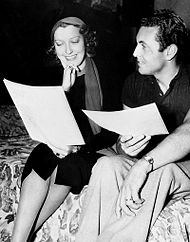
Maytime (1937), with Nelson Eddy, was the highest-grossing film worldwide that year. It is still seen as one of the best film musicals of the 1930s. The song "Will You Remember" earned Jeanette another gold record.
Jeanette then made The Firefly (1937), her first solo starring film at MGM. She sang "The Donkey Serenade" in this movie. The MacDonald/Eddy team took a break after Jeanette married Gene Raymond. However, their solo films did not earn as much money. So, they reunited for The Girl of the Golden West (1938).
MGM then made Sweethearts (1938), their first Technicolor film, also starring Eddy. They played a husband-and-wife Broadway team. This movie won an award for Best Picture of the Year. After this, Jeanette made Broadway Serenade (1939) without Eddy.
Jeanette left Hollywood for a concert tour. She later agreed to film New Moon (1940) with Eddy. This became one of her most popular films. They sang "Lover, Come Back to Me." She then made Bitter Sweet (1940) and Smilin' Through (1941), both in Technicolor.
I Married an Angel (1942) was her last film with Nelson Eddy. After this, Eddy left MGM. Jeanette stayed for one more film, Cairo (1942), a spy comedy.
Later Film Roles
After a break, Jeanette returned to MGM for two more films. She appeared as herself in Follow the Boys (1944), a movie about stars entertaining soldiers during World War II. She sang "Beyond the Blue Horizon."
In Three Daring Daughters (1948), she starred with José Iturbi. Her daughters in the movie tried to get her back with her ex-husband. Her final film was The Sun Comes Up (1949), where she starred with Lassie the dog. She played a widow who finds comfort in an orphan boy.
Jeanette often tried to make a comeback movie. She even considered reuniting with Nelson Eddy or Maurice Chevalier. However, her health issues made it difficult for her to get insurance for filming. She was also considered for the role of Mother Abbess in The Sound of Music film, but her health prevented it.
Jeanette MacDonald was a very popular star. She was listed as one of the top-10 box-office draws in 1936. Many of her films were among the highest-earning movies when they were released. She has two stars on the Hollywood Walk of Fame for her films and recordings.
Musical Theatre Performances
In the mid-1950s, Jeanette performed in stage productions like Bitter Sweet and The King and I. While performing The King and I in 1956, she collapsed. It was announced as heat exhaustion, but it was actually a heart problem. She started to limit her performances. Her last professional stage appearance was in Bitter Sweet in 1959.
Jeanette and her husband Gene Raymond also toured in a play called The Guardsman. The show was popular with audiences, but it never reached Broadway.
In the 1960s, Jeanette was asked to star in a musical version of Sunset Boulevard on Broadway. She also made a few appearances in nightclubs in Las Vegas and Los Angeles.
Music Career and Concerts
From 1931 through the 1950s, Jeanette regularly went on concert tours between making films. Her first European tour was in 1931. Her first American concert tour was in 1939. She performed many times at the Hollywood Bowl and Carnegie Hall.
During World War II, Jeanette helped start the Army Emergency Relief. She raised money on her concert tours. When she was home in Hollywood, she hosted open houses for soldiers. She once sang for 20,000 soldiers in San Francisco who were going to fight in the South Pacific. She closed with "The Battle Hymn of the Republic," and everyone sang along. She raised almost $100,000 for the troops. President Franklin D. Roosevelt gave her a medal for her efforts. She also performed for President Dwight D. Eisenhower at the White House.
Opera Performances
Jeanette MacDonald wanted to become an opera singer. She trained with Lotte Lehmann, a famous opera star. Lehmann said Jeanette was a very hardworking and serious student.
Jeanette made her opera debut in Montreal in 1943. She sang the role of Juliette in Gounod's Roméo et Juliette. She also sang Marguerite in Gounod's Faust with the Chicago Opera Company. Critics praised her performances, saying her singing was beautiful and pure.
Radio and Television Appearances
Jeanette MacDonald had a long radio career. She hosted her own radio show, Vicks Open House, from 1937 to 1938. It was hard to do a weekly live show while also filming movies and touring. She decided not to renew her contract after fainting on air. After that, she made guest appearances on many radio programs.
She often appeared with Nelson Eddy on shows like Lux Radio Theater. They performed condensed versions of their films. She also sang on The Voice of Firestone, which featured top opera singers. In 1953, she sang "The Star-Spangled Banner" at President Dwight D. Eisenhower's inauguration. This was broadcast on both radio and TV.
Jeanette and Nelson Eddy often sang together on radio shows in the 1940s. She also appeared on early television. In 1952, she was featured on This Is Your Life, a surprise show about her life. Nelson Eddy even made a surprise appearance by singing a song from her wedding. In 1956, Jeanette and Eddy made their first TV appearance as a team on the Lux Video Theatre Holiday Special.
Personal Life Story
Jeanette MacDonald was the youngest daughter in her family. She had red hair and blue-green eyes like her father. She loved to socialize and perform for others. She once said she needed people to watch and applaud her as much as she needed food and drink.
Jeanette believed the number thirteen was her lucky number. Her movie characters often had names starting with "M," the 13th letter of the alphabet. This number appeared many times in her life.
On movie sets, Jeanette always sang live, even when the music was played back. She never just moved her lips to the song.
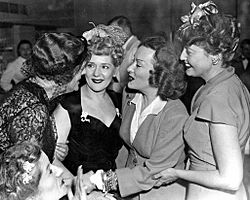
Jeanette had health issues throughout her career, including a heart condition. She sometimes had blackouts and fainting spells. She was often in and out of hospitals. A few years before she died, she became a Religious Scientist. Her health problems meant she couldn't film early in the morning.
Jeanette was a Republican, but she usually avoided talking about politics. She believed in treating everyone equally. She once said, "I sing for Democrats and Republicans, black and white, everyone, and I just can't talk politics."
Relationships and Marriage
Jeanette dated a few people before she married. She was engaged to Jack Ohmeis, an architecture student. She also dated Irving Stone, who worked in his family's business. Later, she dated Robert Ritchie, who became a press agent for MGM.
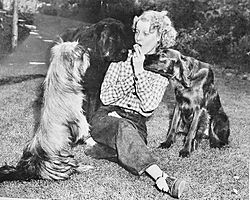
Jeanette MacDonald married actor Gene Raymond in 1937. They met at a Hollywood party. They lived in a large mansion called Twin Gables with their pet dogs and a horse. Jeanette worried about her husband's acting career, which was often uncertain. She wished their success was more equal.
Fans sometimes mistook Gene Raymond for Nelson Eddy. Jeanette said she never liked this. She wanted her husband to get as much recognition as she did. When she met Maurice Chevalier again in 1957, he asked why she stopped making films. She said it was because she had played her best role by her husband's side for twenty years, and she was very happy.
Final Years and Legacy
Jeanette MacDonald passed away from heart failure on January 14, 1965, in Houston, Texas. Her husband, Gene Raymond, was by her side. She had been ill for some time. Her last words to him were, "I love you."
Her funeral was held on January 18. Many famous people attended, including Nelson Eddy, Allan Jones, Maurice Chevalier, Spencer Tracy, and Mary Pickford. Former presidents Harry S. Truman and Dwight D. Eisenhower also sent representatives. Jeanette MacDonald was buried in a pink marble crypt at Forest Lawn Memorial Park, Glendale. Her crypt reads "Jeanette MacDonald Raymond."
Honors and Remembered Achievements
In 1939, Jeanette MacDonald was crowned the "Queen of the Movies." This ceremony was filmed and presented by Ed Sullivan.
She received an honorary doctor of music degree from Ithaca College in 1956. In 1961, she was named Philadelphia's Woman of the Year. She said being recognized in her hometown felt more special than other awards.
After Her Death
After Jeanette's death, her high school classmates donated money in her name to the Children's Heart Hospital of Philadelphia.
The USC Thornton School of Music built a Jeanette MacDonald Recital Hall in her honor. In 1988, a bronze plaque for Jeanette was placed on the Philadelphia Music Alliance's Walk of Fame.
Credits
Filmography
Discography
Jeanette MacDonald recorded over 50 songs during her career. She worked mainly for RCA Victor in the United States. She earned three gold records, including one for the album Favorites in Stereo with Nelson Eddy in 1959.
- MacDonald in Song (1939)
- Religious Songs (1945)
- Operetta Favorites (1946)
- Romantic Moments (1950)
- Favorites (c. 1951)
- Favorites in Stereo (1959)
- Smilin' Through (1960)
- Jeanette MacDonald Sings Songs of Faith and Inspiration (1963)
See also
 In Spanish: Jeanette MacDonald para niños
In Spanish: Jeanette MacDonald para niños


